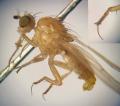Diptera.info :: Miscellaneous :: General queries
|
Are all Bombyllidae cuckoo parasites ?
|
|
| LordV |
Posted on 25-07-2010 08:12
|
|
Member Location: Posts: 673 Joined: 06.09.05 |
A colleague on another forum took some photos of Villa species bee-flies which appeared to be ovipositing just in damp mud with no obvious bee nests around. Are all Bee-flies parasitoids of bees ? Original thread prompting the question here http://www.fredmiranda.com/forum/topic/920503 Brian v. Edited by LordV on 25-07-2010 10:24 |
|
|
|
| viktor j nilsson |
Posted on 26-07-2010 09:53
|
|
Member Location: Gothenburg, Sweden Posts: 203 Joined: 25.02.08 |
Actually, it is a female filling up her "sand chamber", a hollow space in the abdomen where she stores fine sand particles. Then, when she is laying her eggs in the host's nest, each egg is covered and camouflaged using this sand. |
|
|
|
| LordV |
Posted on 27-07-2010 11:42
|
|
Member Location: Posts: 673 Joined: 06.09.05 |
viktor j nilsson wrote: Actually, it is a female filling up her "sand chamber", a hollow space in the abdomen where she stores fine sand particles. Then, when she is laying her eggs in the host's nest, each egg is covered and camouflaged using this sand. Thanks Viktor for the reply. That clears things up  brian v. |
|
|
|
| David Gibbs |
Posted on 27-07-2010 12:17
|
|
Member Location: Bristol, UK Posts: 833 Joined: 17.06.06 |
viktor j nilsson wrote: Actually, it is a female filling up her "sand chamber", a hollow space in the abdomen where she stores fine sand particles. Then, when she is laying her eggs in the host's nest, each egg is covered and camouflaged using this sand. As far as i know most Bombyliidae are ectoparasitoides of the pupae or prepupae of the host invertebrate with a few attacking egg pods so strictly speaking are predators. None are "cuckoos" ie brood parasites or cleptoparasitoides, they attack the insect itself rather than usurp its food store as cleptoparasitoides do. The first part of viktors answer is correct but Villa do not direct their eggs at host nests but broadcast their eggs in any likely habitat. Villa most frequently attack Lepidoptera pupae. Even those species of beeflies which parasitise solitary bees are still prone to scatter their eggs at anything looking vaguely like a hole in the ground. Edited by David Gibbs on 27-07-2010 12:18 |
|
|
|
| viktor j nilsson |
Posted on 27-07-2010 14:23
|
|
Member Location: Gothenburg, Sweden Posts: 203 Joined: 25.02.08 |
Thanks David, that was much more than I knew. |
|
|
|
| Jump to Forum: |












